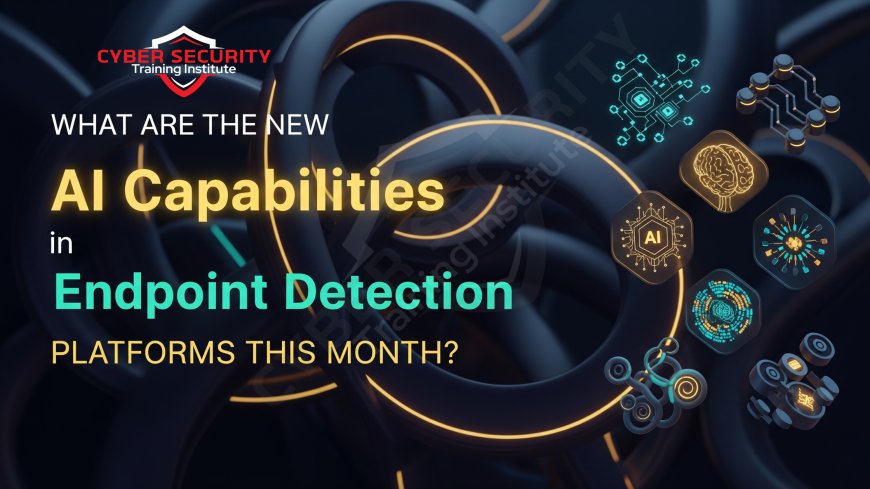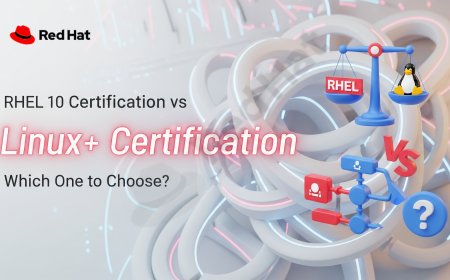What Are the New AI Capabilities in Endpoint Detection Platforms This Month?
The new AI capabilities in Endpoint Detection and Response (EDR) platforms in Q3 2025 are focused on autonomous response and remediation, predictive threat modeling at the endpoint, and deep integration with identity context. Key vendors are using AI to autonomously neutralize threats, predict which endpoints will be targeted, and understand user intent. This detailed analysis for 2025 explores the evolution of EDR from a simple detection and response tool to an autonomous security agent. It details the next-generation AI capabilities being rolled out by market leaders, including autonomous remediation and identity threat detection. The article breaks down the strategic benefits of these innovations for an overworked SOC, discusses the critical challenge of trusting the machine to take autonomous action, and provides a CISO's guide to adopting this transformative technology to create a more resilient and efficient endpoint security program.

Table of Contents
- Introduction
- From 'Detection & Response' to 'Prediction & Prevention'
- The Need for Autonomy: Why EDR Is Getting Smarter
- Inside the Next-Generation AI-EDR Engine
- New AI Capabilities in EDR Platforms (Q3 2025)
- The 'Trusting the Machine' Challenge
- The Future: The Self-Healing Endpoint
- A CISO's Guide to Adopting Autonomous Endpoint Security
- Conclusion
- FAQ
Introduction
The new AI capabilities emerging in Endpoint Detection and Response (EDR) platforms this month are focused on autonomous response and remediation, predictive threat modeling at the endpoint, and deep integration with identity context. In Q3 2025, leading vendors are moving beyond simply detecting threats and are now using AI to autonomously neutralize attacks without human intervention, predict which specific endpoints are most likely to be targeted by adversaries, and understand a user's intent by correlating endpoint activity with their identity and permissions. This evolution marks a critical shift, transforming the EDR agent from a passive security camera into an active, intelligent security robot on every device.
From 'Detection & Response' to 'Prediction & Prevention'
First-generation EDR platforms were a revolutionary leap beyond traditional antivirus. They gave security teams the ability to detect advanced threats based on their behavior and the visibility to respond by investigating and containing the compromise. However, this model still relied heavily on a human analyst in the Security Operations Center (SOC) to connect the dots and initiate the response, a process that could take critical minutes or hours.
The new generation of AI-EDR is shifting the paradigm from detection and response to prediction and prevention. The on-device and cloud-based AI is no longer just a detection engine; it is a decision-making engine. It uses predictive analytics to identify at-risk endpoints before they are compromised. When a threat is detected, it doesn't just send an alert; it can now execute a complex, multi-step remediation workflow autonomously, in milliseconds, effectively preventing the threat from ever establishing a foothold.
The Need for Autonomy: Why EDR Is Getting Smarter
This push towards greater autonomy at the endpoint is a direct response to the pressures facing modern security teams:
The Speed of Automated Attacks: As we've discussed, modern, AI-driven attacks operate at machine speed. A human-in-the-loop response, with its inherent delays, is often too slow to stop a ransomware attack that can encrypt an entire system in minutes.
The Unbearable SOC Workload: The chronic cybersecurity skills gap means that most SOCs are understaffed and overwhelmed. They cannot manually investigate every single EDR alert. Autonomous remediation for high-confidence threats is the only way to make the workload manageable.
The Complexity of Modern Attack Chains: Attacks are no longer single events. They are complex chains that pivot from an endpoint, to a user identity, to a cloud application. EDR needs to be "context-aware" to understand its place in this chain and make a more intelligent response decision.
The Drive for Higher ROI: CISOs need to demonstrate a clear return on investment for their security spending. An EDR platform that can autonomously handle 80% of common threats dramatically reduces the manual effort required from expensive human analysts, providing a clear and compelling ROI.
Inside the Next-Generation AI-EDR Engine
The "magic" of these new platforms lies in the fusion of several advanced AI capabilities:
1. Predictive Analytics Engine: The platform's AI analyzes the posture of every endpoint—its patch level, its configuration, its user's role, and its access rights. It combines this with global threat intelligence to build a predictive model, identifying the top 1% of endpoints that are most likely to be targeted and are at the highest risk.
2. Deep Contextual Correlation: The EDR agent no longer just looks at endpoint telemetry in a vacuum. The platform's AI, often as part of a broader XDR strategy, fuses this endpoint data with real-time signals from identity providers (like Azure AD) and cloud platforms. This allows it to understand the full context of an action.
3. Autonomous Response Module: This is the core innovation. It is an on-device and cloud-based AI decision engine. When a threat is detected with a high degree of confidence, this module can execute a complex, pre-approved response workflow without waiting for a human. This is far more advanced than a simple "block file" action.
4. Generative AI for Investigation: For the threats that still require human analysis, the platform now includes an integrated Generative AI "co-pilot." The analyst can ask the EDR platform questions in natural language, such as, "Summarize the full attack chain for this alert and generate a script to remediate it," drastically speeding up the investigation process.
New AI Capabilities in EDR Platforms (Q3 2025)
These are the groundbreaking features that are defining the EDR market this year:
| New AI Capability | Description | How It Works | Key Benefit for the SOC |
|---|---|---|---|
| Autonomous Remediation | The ability of the EDR agent to automatically and completely reverse the actions of a malicious process without human intervention. | The AI observes a malicious process's actions (e.g., file encryption, registry changes, persistence mechanisms) and then automatically kills the process, deletes the dropped files, and reverts the system changes. | Dramatically reduces the Mean Time to Remediate (MTTR) from hours to seconds. Contains threats instantly before they can spread. |
| Predictive Vulnerability Management | The AI uses the endpoint's context to prioritize which vulnerabilities need to be patched first. | It moves beyond just the CVSS score. The AI identifies a vulnerability on an endpoint and then uses its knowledge of the user, the device's exposure, and active threats to tell you the real risk it poses. | Allows patch management teams to focus on the small number of vulnerabilities that are actually likely to be exploited, making their efforts far more effective. |
| Identity Threat Detection & Response (ITDR) | The EDR agent deeply integrates with the identity provider to correlate endpoint activity with identity-based threats. | The EDR's AI can see that a process on an endpoint is attempting an action that the user's IAM role does not permit, or that a login token being used on the device was generated via a risky authentication. | Provides a powerful defense against attacks that rely on compromised credentials, which is the majority of modern breaches. |
| Generative AI for Investigation (Co-Pilot) | An integrated LLM that acts as a conversational interface for investigating threats on the endpoint. | An analyst can ask the EDR platform in plain English to "Hunt for all PowerShell commands that were run on this machine and explain any that are suspicious." | Lowers the skill barrier for investigation and dramatically accelerates the process of understanding and responding to complex alerts. |
The 'Trusting the Machine' Challenge
The single biggest hurdle to the widespread adoption of autonomous remediation is not technological; it is human. How can a CISO or a SOC manager be comfortable giving an AI the authority to automatically take an action that could have a business impact, such as quarantining a CEO's laptop or shutting down what it thinks is a compromised, but is actually a business-critical, server? Overcoming this challenge requires:
Extreme Transparency (XAI): The EDR platform must provide a crystal-clear, explainable audit trail for every autonomous action it takes, showing the exact evidence and logic that led to its decision.
Fine-Grained Policy Control: The security team must have the ability to set granular policies that define exactly which actions the AI is allowed to take autonomously, on which systems, and under which circumstances.
A Phased Approach: Most organizations will start by running the autonomous module in a "recommendation-only" mode, allowing them to build trust in the AI's decisions before gradually giving it more autonomy over time.
The Future: The Self-Healing Endpoint
The innovation trajectory in this space is pointing towards the ultimate goal: the self-healing endpoint In this future state, the EDR agent will not just be a security tool, but a fully autonomous system administrator for security. When it detects a breach, it won't just kill the malicious process. The AI will perform a full root cause analysis, identify the underlying vulnerability or misconfiguration that allowed the attack to succeed, automatically locate and deploy the correct patch or configuration fix, and then validate that the fix was successful, returning the endpoint to a known-good, hardened state—all without any human intervention. This is the end-state vision for a truly autonomous and resilient endpoint.
A CISO's Guide to Adopting Autonomous Endpoint Security
For CISOs looking to harness the power of this new technology, a strategic approach is key:
1. Start with a "Recommendation Mode" to Build Trust: Begin by configuring the autonomous response module to only suggest actions for your human analysts to approve. Use this phase to validate the AI's accuracy and build your team's confidence in its decisions.
2. Prioritize Platforms with a Strong XDR Strategy: The intelligence of an EDR's decisions is directly proportional to the quality of the data it receives. Prioritize vendors who have a clear and powerful Extended Detection and Response (XDR) strategy that can provide that rich, cross-domain context.
3. Demand Explainability (XAI): Make model transparency and the ability to audit autonomous decisions a non-negotiable requirement in your evaluation process. You must be able to explain every action the platform takes.
4. Develop an Override and Incident Response Plan: You must have a clear "break glass" procedure. Your incident response plan must include the steps your team will take to manually override the AI's autonomous actions if it makes a mistake that causes a business disruption.
Conclusion
Endpoint Detection and Response technology is currently undergoing its most significant evolution since its inception. The integration of advanced AI is transforming the EDR agent from a passive tool for visibility and response into an active and autonomous agent of protection. The new capabilities being rolled out by the leading vendors in Q3 2025—centered on autonomous remediation, predictive analytics, and deep identity integration—are a necessary and powerful response to the machine-speed reality of the modern threat landscape. For CISOs, embracing this move towards autonomy is the key to building a more efficient, more effective, and ultimately more resilient endpoint security program.
FAQ
What is EDR?
EDR stands for Endpoint Detection and Response. It is an advanced cybersecurity solution that continuously monitors endpoints (like laptops and servers) to detect, investigate, and respond to threats that bypass traditional antivirus.
What is "autonomous remediation"?
Autonomous remediation is the ability of an EDR agent to automatically and completely neutralize a threat and reverse its changes (e.g., delete files, revert registry keys) without any human intervention.
How is EDR different from traditional antivirus (AV)?
Traditional AV relies on known signatures to block known malware. EDR uses behavioral analysis and AI to detect novel and unknown threats based on their malicious actions, and provides tools for investigation and response.
What is "predictive vulnerability management" in an EDR?
It's the use of AI by the EDR platform to prioritize which vulnerabilities on an endpoint should be patched first. It does this by correlating the vulnerability with the user's identity, the device's exposure, and active threat intelligence.
What is Identity Threat Detection and Response (ITDR)?
ITDR is an emerging category of security that focuses on protecting identity and access management systems. EDR platforms are now integrating ITDR capabilities to correlate endpoint activity with identity-based threats, like risky logins or token theft.
Is it safe to let an AI automatically quarantine a server?
This is the key challenge of "trusting the machine." It can be safe if the organization has very high confidence in the AI's accuracy and has granular policies that only allow autonomous actions for specific, well-understood threats on non-critical systems. Most organizations start with a human approval workflow.
What is an "AI co-pilot" in EDR?
An AI co-pilot is an integrated Large Language Model (LLM) that allows a security analyst to use natural language to query the EDR data, investigate threats, and generate remediation scripts, making the investigation process much faster.
Who are the main vendors for these new EDR capabilities?
The leaders in the EDR/XDR market, such as CrowdStrike, Palo Alto Networks, and Microsoft, are at the forefront of developing and deploying these advanced AI-powered autonomous and predictive capabilities.
What is XDR?
XDR (Extended Detection and Response) is the evolution of EDR. An XDR platform collects and correlates data not just from endpoints, but also from the network, cloud, identity, and email systems to provide a unified view of an attack.
How does EDR help against "fileless" attacks?
Fileless attacks run entirely in memory. Since EDR focuses on monitoring the behavior of running processes and their use of system resources (like PowerShell), it is the primary defense for detecting and blocking these attacks.
What is a "SOC"?
A SOC (Security Operations Center) is the team of security analysts responsible for monitoring and responding to cybersecurity threats. These new EDR capabilities are designed to make the SOC more efficient.
What does "Mean Time to Remediate" (MTTR) mean?
MTTR is a key cybersecurity metric that measures the average time it takes to completely resolve a security incident after it has been detected. Autonomous remediation can reduce MTTR from hours to seconds.
What is a "CISO"?
CISO stands for Chief Information Security Officer, the executive responsible for an organization's overall cybersecurity program.
How does the EDR's AI learn what is "normal"?
The AI engine ingests telemetry from the endpoint over a period of time to build a "baseline" of normal activity for that specific user and device. It then looks for deviations from this learned baseline.
What is a "playbook" in incident response?
A playbook is a pre-defined set of steps that an incident response team or an automation tool should follow in response to a specific type of security incident.
Does this replace the need for a human SOC team?
No, it changes their role. It automates the low-level, repetitive tasks, allowing the human analysts to focus on higher-value work like complex threat hunting, strategic defense improvement, and managing the AI's performance.
What is "explainability" (XAI)?
XAI is the ability of an AI model to explain the reasoning behind its decisions in a way that a human can understand. This is critical for building trust in autonomous response systems.
What is a "self-healing" endpoint?
This is the future vision for EDR. A self-healing endpoint would not only block a threat but would autonomously identify and fix the root cause (like a vulnerability), returning itself to a secure state without human intervention.
How do I start with autonomous remediation?
The best practice is to start in a "recommend and approve" mode. The AI will detect a threat and recommend the full set of remediation actions, but it will wait for a human analyst to approve them with a single click before executing.
What is the most important benefit of these new AI capabilities?
The most important benefit is speed. They allow the defense to operate at the same machine speed as the automated attacks they are facing, which is impossible to achieve with a purely human-in-the-loop response model.
What's Your Reaction?
 Like
0
Like
0
 Dislike
0
Dislike
0
 Love
0
Love
0
 Funny
0
Funny
0
 Angry
0
Angry
0
 Sad
0
Sad
0
 Wow
0
Wow
0















